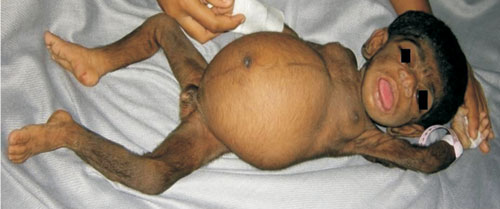Born at term with a birth weight of 1700 g to consanguineous parents,
this 4½-month-old girl weighed 2900 g with a length of 52 cm and head
circumference of 34 cm. She appeared markedly emaciated, and had
hirsuitism, thickened skin with patchy hyperpigmentation, coarse facial
features, sunken cheeks, pointed chin, flared nostrils, broad open
mouth, thick lips, low-set ears, enlarged breasts and clitoromegaly. Her
investigations revealed massively enlarged polycystic ovaries, elevated
estradiol and testosterone levels, hypoglycemia (blood glucose 27 mg/dL)
and hyperinsulinemia (serum insulin of 253 µU/mL). Leprechaunism was
diagnosed on the basis of these clinical features and laboratory
findings. In view of the poor prognosis and young age, this patient was
given symptomatic treatment. She succumbed to pneumonia and septicemia
by 6 months of age.
 |
|
Fig. 1 Hirsuitism, marked emaciation
and coarse facial features in Leprechaunism.
|
Leprechaunism (Donohue syndrome) is a recessively
inherited syndrome of insulin resistance with severe prenatal and
postnatal growth retardation, ovarian hyperstimulation, acanthosis
nigricans and abnormal facial features, as described above. Over 50
insulin receptor mutations have been described which result in profound
insulin resistance and altered glucose homeostasis with fasting
hypoglycemia and postprandial hyperglycemia. Almost all affected
patients die before two years of age. Other congenital syndromes of
insulin resistance are Type A syndrome and Rabson-Mendenhall syndrome in
which growth retardation is less severe, and severe symptoms are not
seen in early infancy.

